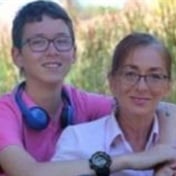
While the sun may be good for you, giving you a healthy glow, you shouldn’t forget too much of a good thing could kill you.
Over-exposure to UV radiation from sunlight and sunbeds increases your risk of developing melanoma.
And of all skin cancers melanoma is the most deadly. Along with Texas and Australia, South Africa has the world’s highest incidence of skin cancer. Nearly 10 000 new cases are diagnosed in SA annually.
Some people are more prone to developing melanoma than others. ‘‘Most at risk are sun bingers,’’ says Dr Ilsa Orrey, a dermatologist at MediClinic Cape Town. ‘‘These are people who stay out of the sun for most of the year and then fry themselves in one go.’’
Just one serious sunburn at any age can increase your risk of developing skin cancer later in life, so if you bowl 40 overs on the trot to the kids in the garden and your neck turns the colour of a fire engine, that’s not good.
Are YOU at risk of melanoma?- Do you have fair skin, light hair, a light eye colour or a tendency to burn easily?
- Did you have large brown moles at birth?
- Are your moles unusual – larger than 5 mm across, irregular in shape or multicoloured?
- Do you have more than 50 ordinary moles?
- Do you have a history of blistering sunburns – especially from when you were running around in the buff as a toddler, or from when you were a teenager?
- Do you spend a lot of time outdoors, working or playing sports? Are you a farmer, fisherman, engineer or geologist, or a cricket, golf or tennis player – anyone who often spends a large part of your day outside?
If you answer ‘‘yes’’ to even one of these questions you should keep a careful lookout for seemingly spontaneous changes to your skin.
SKIN TYPES:
Not all skin types are equally susceptible to developing melanoma. Skin types are graded from zero to six, with zero to three most at risk in the sun and four to six less likely to develop skin cancer.
TYPE 0
Albino skin.
TYPE 1
The person is usually a redhead with freckles who always burns but never tans.
TYPE 2
Skin that usually burns but can develop a tan.
TYPE 3
Skin that sometimes burns but always gets a tan.
TYPE 4
Mediterranean type skin.
TYPE 5
Asian skin.
TYPE 6
Black skin.
Type 6 can develop melanomas, says Orrey, but they’re rare among black South Africans. Dermatologists have however noted an increase in melanoma in dark-skinned West Coast fishermen, illustrating that melanoma is not exclusive to types one to three.
Spot them in time
Constant vigilance is vital. Like speeding fines from highway cameras arriving in the mail, melanomas can suddenly appear with little or no warning. And they don’t necessarily develop from existing moles – they can pop up anywhere and at any time. Many people develop melanoma on their back, head and neck, on their lower legs or even on parts of the body never exposed to the sun.
‘‘You don’t feel ill at all,’’ says Orrey. ‘‘Most melanomas are diagnosed when patients aren’t even aware of anything sinister developing on their bodies. The plus side is that if it’s spotted early enough it’s unusual to die from melanoma.’’
The offending lesion will be removed quickly after being diagnosed and depending on the size of the ‘‘invasion’’ will leave you with a pretty good chance of survival. But if the lesion has penetrated just 1,5mminto your skin your chances of long-termsurvival are slim.
Studies carried out in Australia on patients 10 years after they’d been treated for melanoma found that:
- If the melanoma has not invaded deeper than 0,75mminto the skin your chance of survival can be 98 in 100.
- If the melanoma has penetrated deeper than 1,5mmthere’s a one in 10 chance you won’t survive beyond 10 years.
According to Orrey the age for developing melanoma is dropping – a direct result of increased awareness and earlier detection.
It’s almost impossible to check your own body for possible melanoma and sometimes self-diagnosis can cause a few unnecessarily anxious moments. ‘‘There are a few common mistakes that people make when they examine themselves.” Irritated raised moles, seborrhoeic keratose (harmless skin lesions that develop the older you get, also called senile warts) and bleeds under the skin may look like melanomas.
Often the first sign of melanoma is a change in the size, shape, colour or feel of an existing mole. Most melanomas have a black or blue-black area – it may be ‘‘ugly-looking’’. Melanoma may also appear as a new mole. On the next page we give you the ‘‘A-B-C-D’’ of how to spot a melanoma.
Every exposure counts too and long and regular exposure to the sun can put you at risk as the damage is cumulative. Farmers, cricketers, golfers and others who have long, regular exposure to the sun also have a greater risk of the two other milder forms of skin cancer, squamous cell carcinoma and basal cell carcinoma.
Factor this in
Use an SPF of at least 15 on your body and an SPF of at least 30 on your face. The SPF number tells you how many times longer you can stay in the sun before burning than if you hadn’t used any sunscreen at all. Always be sure to apply sunblock to your ears, nose, neck and hands – they’re prone to bad burns.
Clutching at straws
A straw hat is a waste of time: it has an SPF of about eight only – the protective shade of a tree is about 10.




 Publications
Publications
 Partners
Partners















